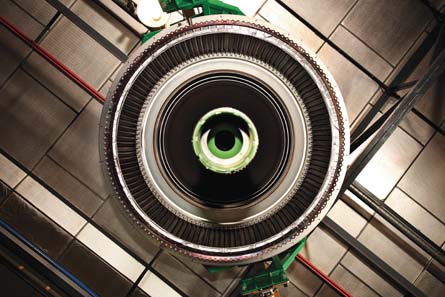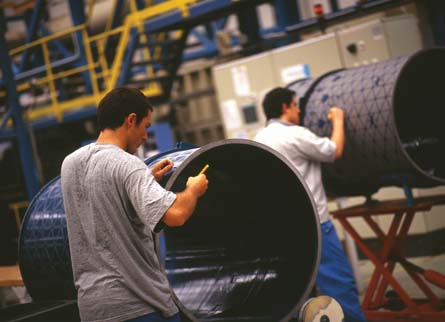Aerospace has become a key economic sector for the autonomous Basque community since its heavy industries declined in the 1970s and 1980s. Today, the traditional engineering region hosts a range of different aviation and space specialists, which contribute to making this stretch of land - by Iberian standards unusually rainy and lush - on the edge of the Bay of Biscay one of the wealthiest parts of Spain.
SENER, the Spanish engineering group founded in the largest Basque city, Bilbao, in the mid-1950s, started the region's aerospace activities in 1966, when it began working on a number of European astronautical projects, leading up to the first Ariane rocket, Ulysses probe and Spacelab.
 |
|---|
© ITP For ITP, the low-pressure turbine is an area of particular expertise |
In February this year, the company inked its largest-ever space contract with the European Space Agency to produce the antenna subsystem for the Solar Orbiter (SOLO) scientific satellite, which is to observe the heliosphere and polar regions of the sun.
The Basque aerospace cluster association, HEGAN, comprises 36 member organisations with approximately 3,700 employees in the region and a total of 10,600 including affiliated plants throughout Spain and elsewhere in the world. Together they registered sales worth €1.2 billion ($1.6 billion at the current rate) in 2010, with around half that volume being generated in the region.
While 2010 was a period of stagnation, HEGAN estimates that last year's total revenues went up by around 6%, while the number of jobs at the respective companies grew by 5%. "Major increases" are expected in the coming years as a result of the planned production ramp-up of new aircraft, especially the Boeing 787 and Airbus A350. If these programmes take off as planned, the total turnover of all HEGAN member plants, including facilities outside the Basque region, will grow by around 80% by 2016.
TURBO PROPULSION
A dominant force in the region is Industria de Turbo Propulsores (ITP). The Bilbao-based engine specialist is co-owned by SENER Group (53%) and Rolls-Royce (47%), and generates around 80% of its turnover - nearly €483 million in total sales in 2010 - at three local component and subassembly production plants. The remaining custom comes from a mainly military-based overhaul shop in Madrid and international maintenance and production facilities.
With the low-pressure turbine (LPT) being its area of particular expertise, ITP developed the module for all Rolls-Royce Trent engines and is responsible for its manufacture on the 900, 1000 and XWB variants, resulting in a 10% workshare in the respective A380, 787 and A350 powerplants. But the company is also involved in other commercial and military engine programmes, including the Eurojet EJ200 and Europrop TP400 for the Eurofighter Typhoon and Airbus Military A400M military transport.
Around 1,260 employees from ITP's total, 2,850-strong workforce are located in the Basque region. The main facility is in Zamudio, near Bilbao, where ITP fabricates components, assembles the Trent LPTs and has its engineering department. The plant also produces the EJ200 exhaust nozzle, which makes it the only site in Europe to develop thrust-vectoring nozzles, according to ITP.
In nearby Barakaldo is a 20,000m2 (215,000ft2) casting facility, employing approximately 150 staff. While it carries the name of the Swiss junior partner Precicast, which holds 20% in the joint venture, ITP owns the remaining majority. The site fabricates mainly LPT vanes for ITP, but also produces other parts, such as compressor vanes and structural components, for external manufacturers including General Electric, Pratt & Whitney and MTU.
The third plant, which is located close to the main Zamudio site and specialises in the production of pipes and ducts, has around 100 employees.
Although ITP has sufficient facility space for the Trent 1000 and XWB production, having expanded its footprint sixfold over the past decade, the company needs to acquire more manufacturing machinery for the ramp-up. Chief executive Ignacio Mataix says that the firm will invest €15-20 million per annum over the next five to six years.
STRUCTURAL MOVES
Aerostructures specialist Aernnova is also hedging its bets on aircraft programmes either side of the Atlantic.
After it delivered the first centre wing box for the Bombardier CSeries in January, the first elevator for the A350 followed last month. Both carbon-composite constructions are manufactured at the firm's main plant in Berantevilla, in the Álava province.
Aernnova also produces the horizontal stabiliser, rudder and main landing gear bay pressure bulkheads for the A350, fuselage and wing components for the 747-8, empennage for the Embraer 170/190 series, and various airframe assemblies for the Sikorsky S-92 helicopter, to name but a few.
Set up as Gamesa Aeronáutica in 1993, the company started fabricating the wing and engine nacelle for the Embraer ERJ-145. When it was acquired by a consortium led by Caja Castilla La Mancha Corporation in 2006, it was renamed Aernnova. Last year, the manufacturer generated a €476 million turnover with around 4,120 employees, a third of whom are located in the Basque country.
Three other facilities - Hegal, Moasa and Fuasa - used to be located in the region, but these operations, including their approximately 600 employees, have been moved to Berantevilla after the company doubled the plant's size to around 20,000m2 last year. The site now serves as assembly centre for both metal and composite aerostructures, and houses the company's management and engineering department.
 |
|---|
© ITP About 1,260 ITP employees are located in the Basque region |
The engineers are working on the design of a laminar-flow demonstrator wing section, which is to be flight-tested as part of the European Clean Sky research initiative on the A340 prototype in 2014, and the "PAMELA" structural health-monitoring system.
Berantevilla is also home to a production plant of aerostructure and engine component manufacturer Aciturri Aeronautica. The company is headquartered in Miranda de Ebro, however - a kilometre or two across the border with the neighbouring Castilla y Leon region.
The nearly 6,000m2 facility in Berantevilla employs around 60 staff members and specialises in metallic components, which largely comprise engine parts for ITP's nearby production line.
While this makes up almost 15% of its custom, Aciturri's main business lies in manufacturing airframe components for Airbus. The company bought a number of other aerostructure specialists across Spain over the past four years to build up both metal and composite capabilities. Today, it produces parts of the A350 vertical stabiliser and aft fuselage; the complete A320 fuselage section 18; passenger doors and horizontal stabiliser leading edges for the A330/A340; and the centre wing box for the CN-235/C-295.
Like its regional neighbours, however, Aciturri wants to diversify its activities beyond Airbus. The company has secured rudder production for the Boeing 737 and, in January, inked a deal with Embraer to design and manufacture the wing-to-body fairing for the planned KC-390 military transport. But competing for such contracts is difficult, admits Ester Porras, head of innovation at Aciturri.
MONEY MATTERS
After much investment by both the private and public sectors over the past 20 years, Spain's aerospace industry has been able to increase its workshare in international programmes and develop the required technology.
"We have done a lot of homework," says Mataix. Nevertheless, he thinks that the Spanish aerospace industry needs to become more productive. As salary increases are being driven by inflation in Spain, and the cost of living rose around 15% faster than in France and Germany, he reports that the sector is battling with an increasing cost disadvantage against its northern competitors.
Government budget cuts are another hurdle, particularly for military programmes such as the A400M, but also in terms of research and development support. Aerospace companies in the Basque region have been directing 15% of their turnovers into R&D, according to HEGAN. But the sector also enjoyed public aid for its work. If this dries up, it will have an impact on future work and growth.
"In our industry you can never stop. If you see an opportunity, you will not see its [return] in the short term but in five years from now," says Mataix. "If you don't invest in a programme it will not create a hole now but in four, five years. We need to invest in new programmes and platforms to maintain our growth."
Source: Flight International






















